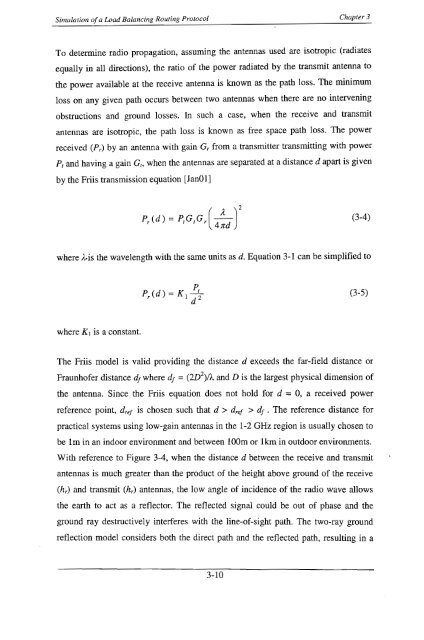Gugrajah_Yuvaan_ Ramesh_2003.pdf
Gugrajah_Yuvaan_ Ramesh_2003.pdf
Gugrajah_Yuvaan_ Ramesh_2003.pdf
Create successful ePaper yourself
Turn your PDF publications into a flip-book with our unique Google optimized e-Paper software.
Simulation ofa Load Balancing Routing Protocol Chapter 3<br />
To determine radio propagation, assuming the antennas used are isotropic (radiates<br />
equally in all directions), the ratio of the power radiated by the transmit antenna to<br />
the power available at the receive antenna is known as the path loss. The minimum<br />
loss on any given path occurs between two antennas when there are no intervening<br />
obstructions and ground losses. In such a case, when the receive and transmit<br />
antennas are isotropic, the path loss is known as free space path loss. The power<br />
received (Pr) by an antenna with gain Gr from a transmitter transmitting with power<br />
Pt and having a gain G" when the antennas are separated at a distance d apart is given<br />
by the Friis transmission equation [JanOl]<br />
(3-4)<br />
where A·is the wavelength with the same units as d. Equation 3-1 can be simplified to<br />
where K I is a constant.<br />
Pt<br />
P (d) = K I -<br />
r d 2 (3-5)<br />
The Friis model is valid providing the distance d exceeds the far-field distance or<br />
Fraunhofer distance df where d f = (2D 2 )/'A and D is the largest physical dimension of<br />
the antenna. Since the Friis equation does not hold for d = 0, a received power<br />
reference point, dref is chosen such that d > dref > d f • The reference distance for<br />
practical systems using low-gain antennas in the 1-2 GHz region is usually chosen to<br />
be 1m in an indoor environment and between lOOm or 1km in outdoor environments.<br />
With reference to Figure 3-4, when the distance d between the receive and transmit<br />
antennas is much greater than the product of the height above ground of the receive<br />
(hr) and transmit (hr) antennas, the low angle of incidence of the radio wave allows<br />
the earth to act as a reflector. The reflected signal could be out of phase and the<br />
ground ray destructively interferes with the line-of-sight path. The two-ray ground<br />
reflection model considers both the direct path and the reflected path, resulting in a<br />
3-10
















